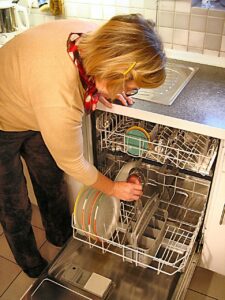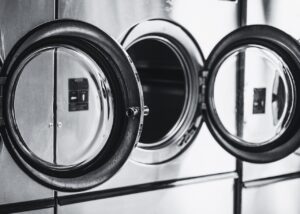A functioning drain pump is a crucial component of household appliances such as washing machines and dishwashers. It plays a vital role in ensuring that water is properly drained from these appliances, preventing potential damage and maintaining their efficiency. In this blog post, we will explore the importance of a functioning drain pump and discuss various aspects related to its maintenance and repair.
Key Takeaways
- The drain pump is a crucial component in your appliance’s drainage system.
- Signs of a malfunctioning drain pump include water not draining or unusual noises during operation.
- Common causes of drain pump issues include clogs, damage, and electrical problems.
- To diagnose a faulty drain pump, check for blockages, test the electrical connections, and listen for unusual sounds.
- Tools needed for drain pump repair include pliers, screwdrivers, and a multimeter.
Understanding the role of the drain pump in your appliance
A drain pump is responsible for removing water from your appliance after each cycle. In a washing machine, for example, the drain pump expels the dirty water from the tub, allowing fresh water to enter for the next cycle. Similarly, in a dishwasher, the drain pump removes the used water from the dishwasher tub, making way for clean water to be used in the next wash.
The drain pump works by creating suction that pulls the water out of the appliance and pushes it through a hose or pipe that leads to a drain or sewage system. It is typically powered by an electric motor that drives an impeller, which creates the necessary suction force. The impeller spins rapidly, drawing in water and expelling it through the outlet.
Signs of a malfunctioning drain pump
There are several signs that indicate a malfunctioning drain pump in your appliance. One common symptom is water not draining properly after a cycle. If you notice standing water in your washing machine or dishwasher, it could be due to a faulty drain pump. Another sign is unusual noises during operation. If you hear grinding or rattling sounds coming from your appliance while it is draining, it may indicate a problem with the drain pump.
It is important to address these issues promptly to prevent further damage to your appliance. A malfunctioning drain pump can lead to water leakage, which can cause damage to other components of the appliance or even your flooring. Additionally, if water is not properly drained from your appliance, it can result in poor cleaning or rinsing performance.
Common causes of drain pump issues
There are several common reasons for drain pump malfunction. One of the most common causes is a clogged pump or drain hose. Over time, debris such as lint, hair, or food particles can accumulate and block the flow of water through the pump or hose. This can prevent the pump from effectively removing water from the appliance.
Another common cause of drain pump issues is electrical problems. The drain pump relies on electricity to power its motor and impeller. If there is a problem with the electrical connection or the motor itself, it can result in a malfunctioning drain pump.
These issues can be prevented by taking certain precautions. Regularly cleaning the pump filter and drain hose can help prevent clogs. It is also important to avoid overloading the appliance, as this can put excessive strain on the drain pump. Additionally, using the correct type and amount of detergent can help prevent soap residue buildup that can clog the pump.
How to diagnose a faulty drain pump
If you suspect that your appliance has a faulty drain pump, there are several steps you can take to diagnose the issue. Start by checking for any visible signs of damage or blockage in the pump or drain hose. Remove any debris that you find and see if it resolves the problem.
Next, you can perform a simple test to check if the drain pump is functioning properly. Start a cycle on your appliance and listen for any unusual noises coming from the drain pump area. If you hear grinding or rattling sounds, it may indicate a problem with the pump.
You can also use a multimeter to test the electrical connection to the drain pump. Disconnect the power supply to your appliance and remove the access panel to gain access to the drain pump. Use the multimeter to check for continuity in the electrical connections. If there is no continuity, it may indicate an electrical problem with the pump.
Tools needed for drain pump repair

If you determine that your drain pump needs to be repaired or replaced, there are several tools that you will need. These include a screwdriver, pliers, a wrench, and a multimeter. The screwdriver will be used to remove any screws or fasteners that hold the access panel in place. Pliers may be needed to remove clamps or connectors from the drain hose. A wrench may be necessary to loosen or tighten any fittings on the pump or hose. Finally, a multimeter will be used to test the electrical connections.
It is important to use each tool effectively and safely. Make sure to choose the correct size and type of screwdriver, pliers, or wrench for the job. Follow any instructions or guidelines provided by the manufacturer of your appliance and the tools you are using. If you are unsure about how to use a particular tool, consult the user manual or seek guidance from a professional.
Steps to replace a defective drain pump
Replacing a faulty drain pump can be a relatively straightforward process if you have the necessary tools and follow the correct steps. Here is a general guide to replacing a drain pump:
1. Disconnect the power supply: Before starting any repair work, make sure to disconnect the power supply to your appliance. This will help prevent any accidents or injuries.
2. Access the drain pump: Remove any screws or fasteners that hold the access panel in place. Depending on your appliance, you may need to remove other components such as the front panel or control panel to gain access to the drain pump.
3. Disconnect the drain hose: Use pliers to loosen any clamps or connectors that secure the drain hose to the pump. Once disconnected, set the hose aside.
4. Disconnect electrical connections: Use a wrench or pliers to disconnect any electrical connections to the drain pump. Take note of how the wires are connected so that you can reconnect them correctly later.
5. Remove the old drain pump: Use a wrench or pliers to loosen any fittings that secure the pump to the appliance. Once loosened, carefully remove the pump from its position.
6. Install the new drain pump: Position the new drain pump in place and secure it with the fittings. Make sure it is properly aligned and tightened.
7. Reconnect electrical connections: Reconnect the electrical connections to the new drain pump, ensuring that they are properly secured.
8. Reconnect the drain hose: Attach the drain hose to the new pump using clamps or connectors. Make sure it is securely fastened.
9. Replace any removed components: If you had to remove any additional components to access the drain pump, make sure to replace them properly.
10. Test the new drain pump: Once everything is reassembled, reconnect the power supply and test the new drain pump. Run a cycle on your appliance and check if the water drains properly.
Tips for maintaining your drain pump
Regular maintenance is key to keeping your drain pump in good condition and preventing future issues. Here are some tips for maintaining your drain pump:
1. Clean the pump filter regularly: Most appliances with a drain pump have a filter that traps debris and prevents it from entering the pump. Clean this filter regularly to prevent clogs and ensure proper drainage.
2. Check for blockages in the drain hose: Inspect the drain hose periodically for any blockages or kinks that may impede water flow. Clear any debris or straighten out any kinks to ensure proper drainage.
3. Use the correct type and amount of detergent: Using too much detergent or using the wrong type can result in soap residue buildup that can clog the drain pump. Follow the manufacturer’s guidelines for detergent usage to prevent this issue.
4. Avoid overloading your appliance: Overloading your appliance can put excessive strain on the drain pump and other components. Follow the recommended load capacity for your appliance to prevent damage.
5. Keep the area around the drain pump clean: Regularly clean the area around the drain pump to prevent dust, lint, or other debris from entering and causing issues.
Preventing future drain pump problems
In addition to regular maintenance, there are several steps you can take to prevent future drain pump problems:
1. Use your appliance properly: Follow the manufacturer’s instructions for proper use of your appliance. Avoid using it for purposes it is not designed for, as this can put unnecessary strain on the drain pump and other components.
2. Avoid putting large or hard objects in your appliance: Large or hard objects can damage the drain pump or other components. Make sure to check pockets before loading clothes into a washing machine and remove any loose items from the dishwasher before starting a cycle.
3. Address issues promptly: If you notice any signs of a malfunctioning drain pump, such as water not draining properly or unusual noises, address them promptly. Ignoring these issues can lead to further damage and more costly repairs.
4. Educate yourself about your appliance: Take the time to read the user manual and familiarize yourself with your appliance’s features and maintenance requirements. This will help you understand how to use and care for your appliance properly.
When to call a professional for drain pump repair
While some drain pump issues can be resolved with DIY repairs, there may be instances where it is necessary to seek professional assistance. If you are unsure about how to diagnose or repair a faulty drain pump, it is best to consult a qualified technician. Additionally, if you do attempt a repair but are unable to resolve the issue, it is advisable to call a professional.
Choosing a qualified and experienced technician is important to ensure that the repair is done correctly and safely. Look for technicians who are certified and have experience working with your specific appliance brand and model. You can ask for recommendations from friends or family, or check online reviews to find reputable repair services in your area.
Cost-effective solutions for drain pump replacement
If you need to replace a faulty drain pump, there are cost-effective options available. One option is to purchase a replacement pump directly from the appliance manufacturer. This ensures that you are getting a high-quality, compatible part for your appliance. However, it may be more expensive compared to other options.
Another option is to purchase a generic or aftermarket drain pump. These pumps are designed to be compatible with a wide range of appliances and are often more affordable than OEM (original equipment manufacturer) parts. However, it is important to ensure that the replacement pump is compatible with your specific appliance model.
When choosing a replacement pump, consider factors such as the warranty offered, customer reviews, and the reputation of the manufacturer. It is also advisable to consult the user manual or contact the manufacturer directly for guidance on choosing the right replacement part.
A functioning drain pump is essential for the proper operation of household appliances such as washing machines and dishwashers. It ensures that water is effectively drained after each cycle, preventing potential damage and maintaining the efficiency of the appliance. By understanding the role of the drain pump, recognizing signs of malfunction, and taking proactive measures for maintenance and repair, you can ensure that your appliance continues to perform optimally for years to come.
In this blog post, we discussed various aspects related to drain pump maintenance and repair. We explored the importance of a functioning drain pump, common signs of malfunction, causes of drain pump issues, diagnostic methods, tools needed for repair, steps to replace a defective drain pump, tips for maintenance, prevention strategies, when to seek professional assistance, cost-effective solutions for replacement, and key takeaways from the blog post. By following these guidelines, you can keep your drain pump in good condition and avoid costly repairs or replacements.
If you’re experiencing drain pump issues with your appliance, it’s important to diagnose and fix the problem as soon as possible. In order to help you with this, we have a related article on our blog that provides valuable information and tips on diagnosing and fixing drain pump issues. Check out our article here to learn more about how to troubleshoot and resolve drain pump problems.
Are the Diagnosis and Fixes for Drain Pump Issues the Same as Pump Predicaments?
When it comes to diagnosing pump problems, the process may differ depending on whether you are dealing with drain pump issues or other types of pump predicaments. The diagnosis and fixes for drain pump issues may not always be the same as those for other pump problems, so it’s important to accurately identify the specific issue at hand.



